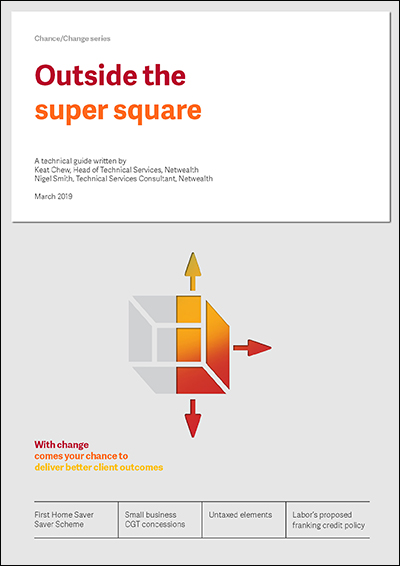Take outs
- The First Home Super Saver Scheme has a new lease of life now that it's within superannuation.
- There are four small business CGT concessions available to reduce or eliminate the tax payable on the sale of the business, once the client meets certain criteria.
- An “untaxed element” can be created on death and result in additional tax being payable by non-tax dependants.
- Retail superannuation funds may be a solution to the ALPs proposed franking credit changes.
Recent years have seen advisers forced to focus on the myriad of complex changes that came into play since 2017. For Netwealth’s 2019 Outside the super square technical roadshow, Netwealth’s Head of Technical Services, Keat Chew decided that it was time to refocus on some neglected areas, and walked advisers through key strategy areas where they may be able to add value to existing client relationships.
His presentation focused on the first home owners super saving scheme (FHSSS), the small business CGT concessions (SBCGT) and key pathways to retirement for small business owners, the additional “death taxes” that may be created by insurance payouts in super, and possible solutions to the Australian Labour Party’s franking credit changes should it gain power in May.
FHSSS – a strategy for all age groups
Chew stated that the FHSSS is an often overlooked tool, saying “I think it (FHSSS) has a new lease of life with the new scheme now within superannuation. You just put in additional [voluntary] contributions, which can be withdrawn later [for the purposes for buying or building the first home] with the added tax benefit. Obviously, you need to know the framework, and you certainly need to know what the criteria are.”
A key strategy highlighted was that re-cycling existing non-super savings through the FHSSS scheme, up to the maximum thresholds, and claiming a tax deduction for the super contribution on the way through results in a positive tax arbitrage benefit. This could increase the final amount available to withdraw, even where it was done over a very short timeframe. The interesting part of this arbitrage strategy is that it is also applicable to parents (and grandparents) who want to help adult working adult children in purchasing their first home – a gift of cash to the adult child allowing them to make a FHSSS concessional super contribution, thereby also giving them the advantage of the tax arbitrage strategy.
Chew was also able to show that even the youngest children could benefit under the FHSSS scheme, as there is no lower age limit on super contributions. In these cases, cash gifted to the minor child could be contributed (by the guardian) as a non-concessional contribution. While there was no initial tax arbitrage benefit, from age 18 onwards when it could be withdrawn, the contributions plus the associated earnings, having compounded over many years, could make up a substantial first home deposit!
“If you have a couple, they're assessed individually. Therefore, if one of them had bought a property before then that person cannot access the scheme; whereas, the other person could still access it. It is based on individual assessment.”
In terms of accessing the money, Chew explains it's easy in the sense that it's not advisers who make the application; it's the client that applies to ATO. The ATO then calculates the maximum withdrawal amount and advises the client. Timing is important, and he pointed out that it’s critical that the ATO releases the payment before a contract is signed, and once the funds have been released to the client, they have 12 months to purchase or build their first home.
He also points out that if the client’s plans change after the amount is released, there is an “escape clause”. Either make a non-concessional contribution equal to the released amount (less PAYG) to super, or keep it and be subject to the 20% FHSSS tax.
These strategies may also provide advisers with the perfect opening to widen discussions with clients to include other family parties – children, parents and grandparents, where such strategies may be relevant – depending who your client is.
“It really can be a strategy for everyone,” says Chew.
Outside the super square - A technical guide
This guide explores four alternative super strategies, to get you thinking differently about superannuation.
Selling a small business – minimise the CGT and get the maximum amount into Super
Keat then explored how the proceeds from the sale of a small business can be used to contribute to super, and emphasised the importance of the financial adviser being involved before the sale is finalised.
“We need to think about other caps that we could use, and that's the small business $1.48 million capital gains tax (CGT) cap that we should be looking at. It’s only available to small business owners on the sale of eligible assets, which is primarily the sale the business, but it could include a property or building that they use in their business as well.”
Chew said there are four small business CGT concessions available to reduce or eliminate the tax payable on the sale of the business, once the client meets certain criteria. The four concessions are the 15-year exemption, the 50% active asset exemption, the small business retirement exemption, and rollover relief. But he emphasised that only two of these – the 15-year exemption and the retirement exemption ($500,000 lifetime cap) – can be used together or individually, up to the lifetime $1.48m cap, to direct money into super. Therefore, these are the two which deserve advisers’ extra attention.
“The small business concessions are not counted against the contribution caps, but do form part of the total super balance, so timing of the contributions can be critical in maximising the total amount into super. Utilising the SBCGT concessions to make a contribution to super prior to making any non-concessional contribution could put you above the total super balance of $1.6m. While that is not a problem in itself, it will preclude any further non-concessional contributions. Alternatively, make your non-concessional contributions first, even up to the total super balance of $1.6m, and still make the contribution under the SBCGT concessions as these are exempt from the total super balance test. In this way, we can maximise the amount in tax concessional super. That's what we should be aiming to achieve.”
Chew ended this segment emphasising that the SBCGT eligibility rules were very complex and would normally be the responsibility of the accountant, particularly where more complex corporate and trust structures are involved. However, to help advisers interact with accountants, the Tech Team had produced a step-by-step flow chart to help navigate these complexities and leave the adviser more time to concentrate on how to use the concessions to maximise the super benefit to the client, which was where the adviser had a crucial role.
Untaxed element – the hidden death tax
Keat moved onto how in certain situations, an “untaxed element” can be created on death and result in additional tax being payable by non-tax dependants.
“When we talk about death benefits, we talk about death lump sum payments, we talk about pensions, but we seldom talk about the untaxed element,” he said. “You don't normally get it arising in a taxed fund in a normal lifetime; it's only on death where a death lump sum payment is made, which includes an insurance payout.
“Where there is a death lump sum, and there are life insurance proceeds, the untaxed element will arise.”
If the dependant keeps it in the same fund and takes a pension, or exits super taking it as a death benefit lump sum, it doesn't arise because there is no tax payable on these benefits received by a tax-dependant death beneficiary.
“Where I have concern is because from 1 July 2017, a death lump sum can now be rolled over (by a tax-dependant death beneficiary to begin an income stream). For example, if you have someone who has died in another fund, and you see you're going to go to a better fund and you roll over with this, there's a problem because it's a death lump sum, it's got insurance, and if it's rolled over to us, then there's a 15% tax on it – the untaxed element.
Chew outlined three strategies for advisers to think about when trying to reduce the untaxed element.
The first strategy was to increase the service period. “Pre-1983, we used to roll over a dollar or so, and it still happens. You can still roll over some money and to inherit a longer service period. If you can do that, if you have one of those legacy old funds, then that would be good to roll over into the fund with death insurance cover.
The second was … “to maintain the insurance cover in another fund. If you maintain it separately then at least it will not impact the accumulated balance, but that other fund (with insurance cover only) still has a problem. That's when you need to think, maybe if you have non-dependents, then insurance cover should perhaps be outside super.”
The third was to avoid making non-concessional contributions to a fund where an untaxed element is expected, as the tax-free component reduces the taxed element which results in an increase to the untaxed element.
Chew ended by noting that advisers needed to be aware of this trap at two levels. The first was to consider the above strategies before death in order to minimise the untaxed element. The second, and far less visible trap, was when dealing with death benefits for beneficiaries, as rolling over to a better fund could crystallise an untaxed element and cost the client significant tax.
Franking credits
As the Federal election looms, the proposed Australian Labor Party (ALP) policy to make excess franking credits non-refundable is high on the list or priorities for many clients.
“What it's trying to do is unwind the policy that was introduced in 2007,” Keat said. “It (the ALP’s proposed policy) is a direct hit to SMSFs. If the SMSF is in full pension, with no tax to pay, then they’ve lost the franking-credits. Even if they create a mix of accumulation and pension – say by bringing in a couple of kids in accumulation mode – I would have a concern because this might not be enough to absorb the franking credits, so partial recovery is probably the best situation you can get.”
Keat said that despite it being only a proposal, there is some evidence that SMSFs are winding up for this reason. However, he pointed out that there may be a solution by using a retail superannuation fund.
“Younger and growing retail super funds normally have stronger accumulation in-flows and high taxable earnings as well as tax-free pension accounts. This often allows them to utilise 100% of the franking credits against the significant tax liability of the fund and pass back the franking benefit refund in full to the pension accounts. However, it depends on the structure of the retail fund, too, because if they are not structured appropriately there may be issues with their ability to recover credits.”
“It’s an opportunity for [SMSFs] to think about whether they actually need that (SMSF) structure or not, and whether they may be better served rolling to a suitable retail fund - this could be the last nail in the coffin for many of them,” Chew said. “I wouldn't just say blindly, ‘move them out’. It might be that an SMSF remains appropriate for them, but if not, then think about an alternative.”
Finally, Keat reminded advisers that this proposed policy may also impact individuals, particularly those with low taxable income resulting in a nil or low tax liability. As always, he had a couple of final “light bulb” solutions which included the possibility of restructuring finances to gain a Centrelink pension, and therefore move yourselves into the pensioner exemption; or use a family trust to stream franking credits to beneficiaries who can use them.
Download the technical guide to learn more about these strategies and access the resources from our adviser roadshow.
Insights
Latest: Managed accounts during volatility and beyond
Four advisers share how managed accounts can enhance your client value proposition.
Special reports: Take a deep dive
Our collection of guides take a deep dive on topics including AdviceTech, managed accounts and cultural trends.
Podcasts: Between Meetings with Matt Heine
Netwealth's Matt Heine chats to industry thought leaders on the opportunities they see for financial advisers.
Webinars: Grow your Business IQ
Recordings from our monthly webinar series, covering a range of topics presented by industry professionals.
Views expressed are of the interviewee and may not be the opinion of Netwealth or its related companies.







